In an ever-changing digital world, cybersecurity threats are on the rise, making it imperative for every business to implement robust measures to protect its data and systems.
Solulan, an expert in IT services and cybersecurity in Quebec, presents you with the best cybersecurity practices for businesses, for strengthening your company's security.
1. Regularly assess your cybersecurity risks
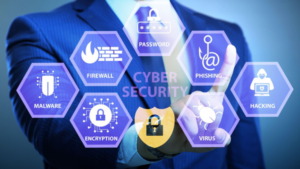
Before you can effectively protect your business with the best practices, it's essential to know exactly what your weak points are. Regular risk assessment is a crucial step in any cybersecurity strategy. It enables you to identify potential vulnerabilities and prioritize the actions you need to take to correct them.
By carrying out regular security audits and penetration tests, you can spot emerging threats, whether they come from outside (such as targeted cyber-attacks) or from within (such as vulnerable software or inadequate configurations).
It's advisable to enlist the help of cybersecurity experts to carry out these IT security audits and penetration tests. These specialists can not only help you identify risks, but also prioritize them according to their criticality, and implement appropriate solutions.
2. Train your employees in cybersecurity

Raising awareness of cybersecurity in the workplace is the first best practices for any business. It is an aspect that is all too often neglected, yet it is of paramount importance. Employees are often the first line of defense against cyberthreats, but they can also be vulnerability vectors if they are not properly trained. Most cyberattacks exploit human errors, such as clicking on a phishing link or using weak passwords.
It is therefore essential to train your employees in data protection, and to train them to recognize threats and adopt secure behaviors, such as :
- Password management (use of strong, unique passwords, adoption of a password manager)
- Phishing awareness and recognition of phishing attempts
- The importance of software updates
- Securing work devices (such as VPNs and antivirus software).
By offering ongoing training to your teams, you reduce the risks associated with human error and strengthen corporate cybersecurity.
3. Implement identity and access management
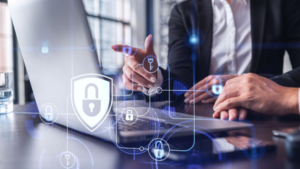
Identity and Access Management (IAM) is one of the fundamental best practices for protecting your business's information systems. This approach enables you to control who can access your digital resources, and under what conditions. It's crucial to limit access to sensitive data to only those employees who really need it to do their job:
- Principle of least privilege: Grant each employee the minimum authorizations necessary to perform his or her tasks. This limits the potential damage if an account is compromised.
- Two-factor authentication (2FA) : 2FA, also known as two-factor authentication, is a measure that strengthens access security by adding a second layer of verification (such as a code sent by SMS or a dedicated application). This makes it more difficult for attackers to hack into an account, even if they have managed to recover a password.
- Centralized identity management: By using a centralized access management platform, you can track and manage the authorizations of all your users in one place. This gives you greater control over who accesses what, and enables you to react quickly in the event of a security breach.
This strict access management is essential to prevent corporate cybersecurity risks, including unauthorized access to sensitive information.
4. Secure your communications and infrastructures

With the increase in teleworking and remote communications, it has become essential to secure information exchanges and the underlying infrastructures within the company.
Communications security is not just about installing antivirus software or firewalls, but also about protecting the network infrastructures that carry this data. Cyberattacks are increasingly targeting entry points such as servers, routers and other critical network elements.
Here are a few best practices for communications and infrastructure security:
- Data encryption: Use encryption protocols (such as SSL or TLS) to protect data in transit. This ensures that information exchanged between your employees or with external partners cannot be intercepted or read by third parties.
- Use of VPNs: Encourage your employees, especially those working remotely, to use virtual private networks (VPNs). These tools encrypt Internet connections, preventing man-in-the-middle attacks where hackers intercept communications.
- Securing network infrastructures: Ensure that your network infrastructures, such as routers, switches and firewalls, are optimally configured and protected by robust security solutions. This includes patch management, intrusion monitoring and strict access policies.
- Secure messaging tools: Prioritize the use of messaging platforms that offer advanced security features, such as end-to-end encryption. Tools like Microsoft Teams, properly configured, can offer this kind of security.
5. Implement terminal security solutions

Computer, telephone and tablet terminals are often the main targets of cyberattacks. They can be exploited to introduce malware, steal data or gain access to corporate networks.
Implementing endpoint security solutions is therefore an essential cybersecurity best practice:
- Anti-virus and anti-malware installation: Make sure that all your company's terminals are protected by security software that is regularly updated and constantly monitored by cyber-security analysts (MDR, XDR).
- Terminal access control: Limit physical and virtual access to company devices. For example, use automatic screen-locking systems and password protection.
- Regular updates: Software updates (from the likes of Microsoft to more niche software) correct security flaws and bugs that can be exploited by attackers. Make sure all operating systems and software are always up to date.
Call on Solulan to implement effective cybersecurity solutions!
6. Set up an incident response plan

Even with the best protection, no company is completely safe from a cybersecurity incident.
In this idea, one of the best cybersecurity best practices for any business is to have an incident response continuity plan in place, so you can react quickly and effectively in the event of a cyberattack. A good plan helps to minimize damage, restore systems more quickly and limit disruption to operations:
- Incident identification: Create processes to quickly detect any suspicious activity or intrusion attempts. This can include network monitoring tools or anomaly detection solutions (discussed later).
- Clear communication: Make sure all stakeholders know what to do in the event of an incident. Designate a responsible team to coordinate actions and communicate internally and externally (customers, partners, etc.).
- Contain and eradicate the threat: Once an incident has been detected, it is crucial to act quickly to contain the attack (by isolating compromised systems, for example) and eliminate the threat (by removing malware, reinforcing firewalls, etc.).
- Recovery and restoration: Once the threat has been eradicated, systems need to be restored from sound backups and checked for vulnerabilities.
7. Enhance the security of your software
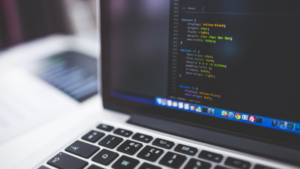
The security of the software you use on a daily basis is another pillar of your cybersecurity strategy. Unsecured or obsolete software represents an ideal entry point for hackers. Here are a few cybersecurity best practices to protect your software:
- Regular updates: Make sure that all your software, from the operating system to specific applications, is regularly updated. Updates often include security patches for discovered vulnerabilities.
- Securing in-house applications: If your company develops software in-house, it is imperative that it undergoes rigorous security testing before deployment.
- Use security software: Integrate software protection solutions, such as application firewalls, to monitor interactions between your software and external networks. This helps block attempts to exploit known vulnerabilities.
- Explore MDR and XDR solutions: MDR (Managed Detection and Response) solutions give you the benefit of continuous threat monitoring, with cybersecurity experts analyzing alerts and reacting quickly to incidents. XDR security (Extended Detection and Response) on the other hand, offers extended visibility and detection across all your systems (networks, endpoints, e-mail, etc.), making it easier to respond to complex threats by aggregating and correlating data from multiple sources.
8. Use anomaly detection tools
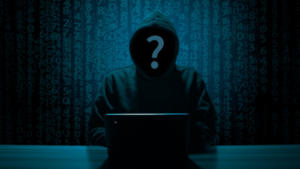
To complement your defenses, it's essential to have anomaly detection tools capable of identifying suspicious behavior or abnormal activity within your network. These tools use advanced techniques, such as artificial intelligence or machine learning, to monitor and analyze data in real time.
In addition to monitoring your internal systems, it is increasingly important to monitor the Dark Web, where stolen information can be exchanged or sold.
- Proactive detection: Instead of waiting for an attack to occur, these tools can spot the early signs of a threat and alert security teams before damage is done. What's more, by monitoring the Dark Web, you can be alerted if sensitive company data is circulating online.
- Behavioral analysis: Anomaly detection tools observe normal user and system behavior. If any activity is out of the ordinary (for example, an employee suddenly uploads a large amount of data at an unusual time), the tool issues an alert.
- Rapid response: By identifying anomalies quickly, you can react before sensitive data is compromised or an attack gains momentum.
These tools are a valuable asset for strengthening corporate cybersecurity, as they can detect threats before they cause damage, including those emerging on platforms such as the Dark Web.
9. Create a clear IT security policy
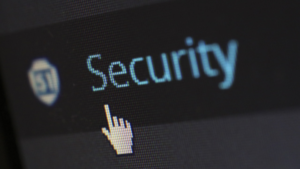
Establishing a clear, well-defined IT security policy is one of the most important cybersecurity best practices for business. This policy should serve as a frame of reference for all your employees, clearly defining expected behaviors and security measures to be followed on a daily basis.
- Password management: Establish strict rules for the creation and management of passwords (minimum length, alphanumeric character, regular change). Encourage the use of password managers for greater security.
- Use of personal devices: If your employees use their personal devices for work (Bring Your Own Device, BYOD), make sure that adequate security measures are in place (e.g. antivirus installation, data encryption, etc.).
- Sensitive data management: Define what data is considered sensitive, and how it should be handled. This includes rules on data storage, restricted access, and secure destruction of information when no longer required.
- Ongoing training: Corporate cybersecurity awareness must be an ongoing process. Make sure employees receive regular training on new threats and good security practices.
Working closely with a partner who is an expert in managed cybersecurity is more than advisable to implement the best IT strategy for your company.
10. Secure your backups
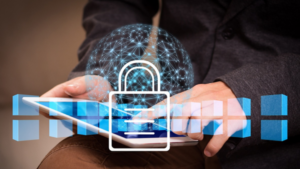
Our last cybersecurity good practice is maybe one of the most vital.
Backups are often overlooked, but they represent an essential cybersecurity practice to protect your data in the event of a major incident. Ransomware, virus attacks or even human error can result in the loss of critical data. That's why securing your backups is paramount.
Here are a few recommendations for securing your backups:
- Regular backups: Make sure that data is backed up regularly, ideally on a daily basis for critical data. This ensures that you can quickly restore your system in the event of an attack or breakdown.
- Offline storage: It's essential not to keep all backups on the same network as your operating data. Use offline or cloud backup solutions to prevent an attack from compromising both your active data and your backups.
- Encrypting backups: Backups must be encrypted to prevent them being compromised in the event of unauthorized access. Encryption protects your data and ensures that only authorized users can restore it.
By securing your business data on backups, you can ensure continuity of operations and reduce the impact of any incidents, guaranteeing better protection against cybersecurity risks for businesses.
Increase your company's cybersecurity with Solulan!
Cybersecurity is crucial to the protection of any company's data and systems. By implementing the best practices described in this article, and relying on a corporate cybersecurity expert like Solulan, you can secure your infrastructures, train your teams and respond to threats with maximum efficiency.
With our cybersecurity services for business, we offer proactive protection and enhanced responsiveness to cyber threats. Our team of specialists is on hand to support you every step of the way, from risk assessment to implementing the solutions best suited to your specific needs.
Contact us today to find out how we can strengthen your company's security and protect your critical resources against cyberattacks. Solulan is your trusted cybersecurity partner
Discover all our cybersecurity services for businesses